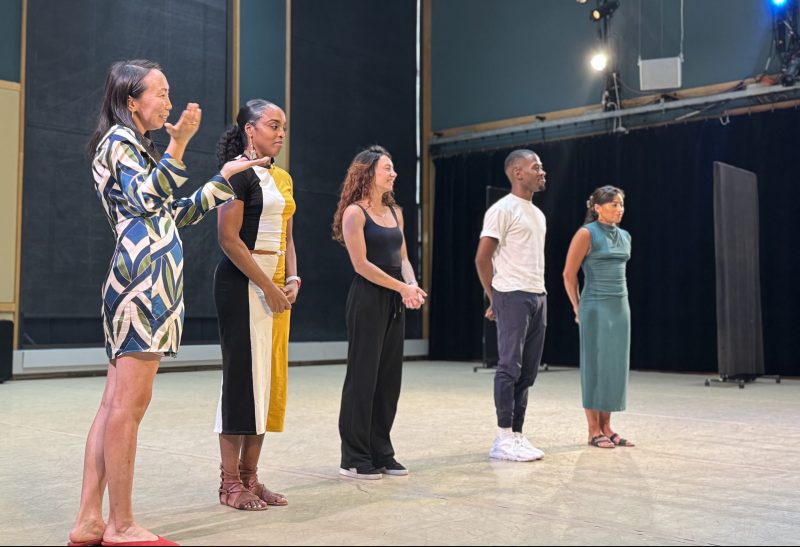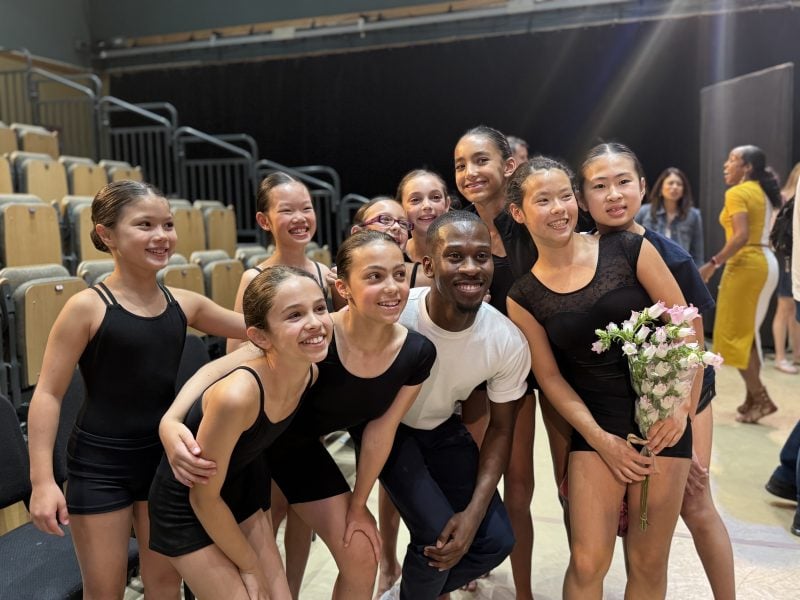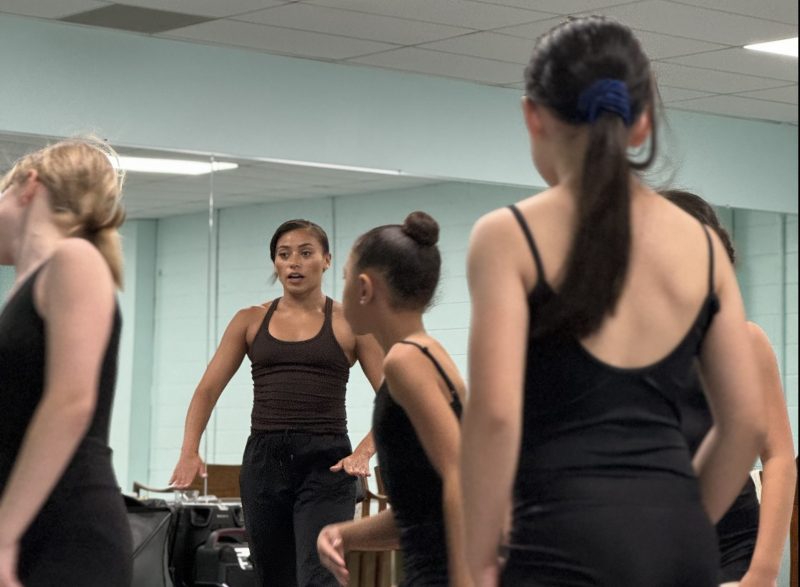©2024 Kim Kokich
Talking with Philadanco! company members, it is clear that although each one has a unique teaching style and perspective, they have one vital characteristic in common: a love of passing on what they have learned. During the second week of this year’s Summer Intensive, the four instructors gave generously of their time to discuss why they enjoy teaching at CityDance Conservatory. We are particularly happy to welcome back CityDance alumna Brittany Wright, who graduated from the Conservatory in 2017 and now dances with Philadanco! And is teaching in their Summer Intensive here. She says she loves coming back because, “It’s the environment, the kids, so full of creativity, constant investigation for more. And I just remember every time coming into these studios being so inspired by my peers. Everybody was so passionate, hardworking and diligent….And I had that work ethic and drive, consistent push, especially I think when you’re around people who are so talented, it makes you really drive. And so I found that that stayed with me even after I left CityDance and it served me to be where I am today.”

It’s the fourth Summer Intensive for Philadanco! And the first for Floyd McLean who says our Conservatory students, as well as those students who are here for their first Summer Intensive, are uniquely receptive–which makes the teaching experience especially gratifying for both student and teacher, “Coming to City Dance Conservatory and meeting the students for the first time is really a gift. They are absolutely wonderful.They come in and they’re like sponges.They want to learn. And I think that really makes it easy on this end because, you know, the more that they soak up the more that I just want to give. So that’s always a treat.”

Floyd works with younger children and says their enthusiasm and energy level inspire him, “The ages that I teach range from about nine to twelve. So, you know, a really, really great age for soaking in absolutely everything possible. And they’re so excited. They’re filled with energy. So it makes me want to match that.”
It’s the fourth summer at CityDance for Principal Dancer and Associate Artistic Director, Janine Beckles. She agrees with Floyd, and adds that coming to CityDance Conservatory “Feels like home. It’s welcoming here. Everybody is so nice and every year I feel like we get closer and closer. Some of the students I remember being in other levels because I teach levels five and six and I’ve seen them grow up. It’s been four summers, so every summer I’m seeing them develop, I’m like, oh my God, you look great! They continue to progress and it’s wonderful to be here in this space.”
In a mere two short weeks, the students experience the highest level of dance immersion, learning some of the most challenging dance techniques and styles for which Philadanco! Is best known. Janine describes how she approaches her students when introducing them to different Modern Dance styles and techniques. “I taught them Horton as well as Graham, and they were able to pick up everything. From last Monday until one week later, big difference. The small things that I noticed, particularly in the Horton technique, [such as] the flat backs areas were cleaner, and just how they were going across the floor, [with] a little bit more of an attack. Basically the technique is stronger, so I’m happy, very happy.”
It’s the third time teaching in the Philadanco! Summer Intensive for Mikaela Fenton. She says she especially enjoys seeing students from around the region rise to the high standards of CityDance Conservatory students, “You have students coming from all over, on top of the already set standard of students that are here all year round. So it brings this new kind of hunger and this new excitement to have a plethora of teachers that CityDance offers, which is very unique, to having ballet all day long and then all of these different modern techniques and trainings in the afternoon, on top of being able to train technically but then learn rep from all of these major companies and all of these major instructors I think it is amazing, and I think it’s something that’s very unique to City Dance.”

Mikaela says she wishes there had been CityDance Conservatory Summer Intensives when she was beginning her own training, “CityDance is something I wish I could have experienced when I was younger. I didn’t have the opportunity to do a lot of summer intensives, but I think
specifically to CityDance, it’s nice because, again, you’re dancing all day long. You’re getting your ballet training in multiple different classes from multiple different teachers. You’re getting different types of modern training, multiple facets, multiple different teachers. You’re getting into dance history, and you’re getting to learn about everything that came before you prior to be able to take it to the next level, take it to the future, which is very exciting. I think it’s very imperative for the younger students and upcoming dancers and artists to know what came before them so they know how to continue and grow and evolve this thing that we all love so much. Again, they are exposed to different teachers teaching dance history. They’re getting all different levels of dance history from all different areas, from all different countries, from all different cultures, which is something that is important, that is something that’s needed that we don’t see a lot.”
Janine Beckles says it’s especially important to give students the tools to be able to adjust, and often shares her own experience of the transition from being a student to being a professional company member. She believes it’s important to build rapport with her students and be honest when describing these experiences, “I tell them my experience, and we have talks. Immediately after dance history, we’ll go on one-on-one talks, and I’ll just basically tell them my goals for not just myself as an artist, but for them. Growing up, things were handed to me in a sense. I hate to say it like that, but it was easy. I was on full scholarship at Alvin Ailey, went to School of American Ballet. Things were just easy, and then when I got into companies, it was drastically different. When you’re new into a new space, when you get into a company, the first thing you have to do is assess the area and assess what they need. You may think you know it all, because I was a know-it-all [but] they put me in my place, and I really appreciated it. It humbled me. I told them, that’s the first thing. It’s not about your talent and ability. It’s about how you come into the space and be able to be welcome and open. I honestly feel like with this group in particular, they ask me questions, and I answer them honestly. I hate when people sugarcoat stuff. If you need any assessment, because I tell them the truth, being at Philadanco! was drastically different from being in the other companies that I danced in. I told them that was an adjustment for myself. They’re like, really? Yes. I was uncomfortable. I was nervous. When it comes to castings, I still get nervous. I was like, this is life. It never changes. You just have to go with the flow and be open to anything that comes.”
This honest and yet gentle approach allows our Summer Intensive students to be aware of and understand the demands of a dancing career while still preserving their sense of self. When asked about what he would like to see as best possible outcomes for his students, Floyd wants to make sure they understand that the exposure to the arts, specifically dance, can make all the difference in their life choices. He wants them to know that “an artist is someone who inspires, who makes people want to better themselves, make their day better or go and do something, see something new, want something new because…I’m not dancing all the time. I can take things from other art forms and put them into other things.”
Mikaela Fenton reflects on how being a dance artist has affected her personal growth and hopes her students can reap the same benefits no matter what they end up pursuing in life. “I think now I’m understanding it’s like this constant deepening of yourself that is just always activated, and it’s like you have to continue investigating yourself, and so I think something I want to make sure that I’m instilling in the students is that when you start to ask yourself those questions and when you start to investigate yourself and when you start to be curious about things and be able to put your own voice into it is when all the magic starts to happen, and those are the things that you can’t teach, but those are the things you can give tools to so they can then be their own teachers and they can start to do their own work, and I believe as a teacher that is the priority rather than standing in the front of the room and trying to make someone emulate you or trying to make shapes and build shapes and only be about the movement. The movement is imperative. That’s the foundation, but then what’s the work that happens after that, and I think as a teacher that’s my responsibility to make them aware of that, and then it’s up to them to create that.”
For CityDance Conservatory alumna, Brittany Wright, the idea that her students will benefit all their lives from this experience is testament to the wonder of dance. She says, “I just feel like dance is so beautiful. It lets us express our own internal light and that’s what I just want to share with them. To just share and express their own authentic selves. And it’s so beautiful seeing young little ones start to tap into that and start to be like, ‘This is my power. This is my light’ and I’m sharing it and getting to witness that growth and progression over the two weeks.’

On Friday June 28th, the last day of the Philadanco! Summer Intensive, students performed a variety of repertory in our Studio Theater at Strathmore, that they’ve been taught by these fabulous instructors–demonstrating to their families, friends, and teachers what they’ve learned and will carry forward into their futures.

- Lester Iradell Horton (1906 – 1953). American dancer and choreographer, best known for evolving modern dance technique.
- Martha Graham (1894 – 1991). American dancer and choreographer, best known for her use of “contraction and release” as an expressive form of modern dance.
- Rep: Abbreviation for ‘repertory’, dances created by professional choreographers.

